|
Search
this site

View
map of Ethiopia

View
map of Africa
Copyright © All World
Vacation Station
|
 |


TRAVEL
READING ON AFRICA:
|
|

Ethiopia Travel Guide
Ethiopia:
Ancient Churches, Semitic Culture, and the Amharic Language
Paradise
Lost (Ethiopia)
Ethiopia, officially
the Federal Democratic Republic of Ethiopia, is a landlocked country (after
the independence of Eritrea in 1993) situated in the Horn of Africa. It
is bordered by Eritrea on the north, Sudan in the west, Kenya in the south,
Djibouti in the northeast, and Somalia in the east. The second-most populous
African nation, Ethiopia is one of the oldest nations in the world, and
the only African nation to have enjoyed continuous sovereignty throughout
and beyond the Scramble for Africa, excepting a brief occupation in World
War II. Often regarded as the "Cradle of Humanity" for the peerlessly
ancient traces of humanity unearthed there, Ethiopia is also the second
oldest Christian nation, having maintained its Christian character since
the 4th century AD. |
| Historically an intersection
of African and Middle Eastern civilizations[citation needed], Ethiopia
has more recently become a crossroads of global international cooperation:
it was a charter member of the League of Nations in 1923 and the Declaration
by United Nations in 1942, founded the UN headquarters in Africa, was one
of the 51 original members of the United Nations, and is currently the
headquarters for and the main founder of the former Organisation of African
Unity and current African Union. |
|
Top
|
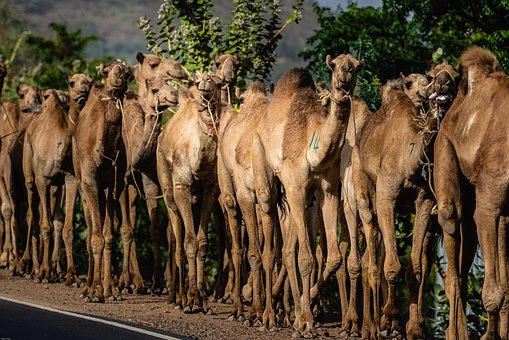
Paradise
Lost by Susan Scharfman
Travel to an African country
that borders Sudan, Somalia, Kenya and Eritrea can be dangerous to your
health in more ways than one. But, if you're a skydiving, snowboarding,
tomb raiding Indiana Jones kind 'a trekker, you might find Ethiopia just
your cup of strong coffee.
Since the murder in 1975
of the emperor, strangled in the basement of his palace, Ethiopia has seesawed
from absolute rule by a God-King, to Marxist/Military totalitarianism to
the present Federal Democratic Republic of Ethiopia with a Constitution.
Though tribal blood feuds do exist in parts of the country, the U.S. has
an embassy in Addis Ababa, and you can check the State Department's travel
alerts.
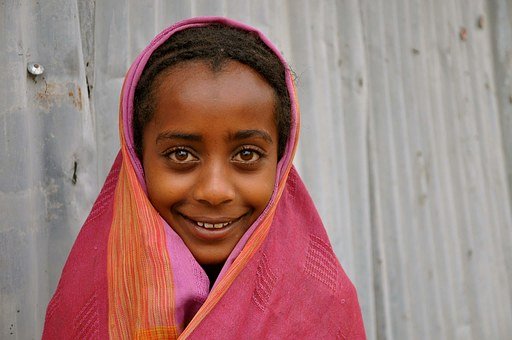
The Last Emperor
Now that you've packed and done
your homework, you're ready to go. You've read that Ethiopia's history
goes back to the dawn of man. Archaeologists have unearthed human remains
that carbon-date 3.2 million years ago. I worked in the capital, Addis
Ababa during the reign of Ethiopia's last emperor.
A tiny man with a title larger
than himself, "Emperor Haile Selassi I, Conquering Lion of the Tribe of
Judah, Elect of God, King of Kings of Ethiopia" proclaimed himself the
direct descendant of Menilek I, son of King Solomon and the Queen of Sheba.
Each Christmas Day, the emperor
opened his palace to foreign embassy bigwigs for tea and sweets while his
pet lions strolled around the gardens. I got to go only because I was taking
photos for an official brochure. Can you imagine tea with Haile Selassi?
I lived near the palace and went to bed each night to the screech of peacocks
and the roar of those noisy cats.
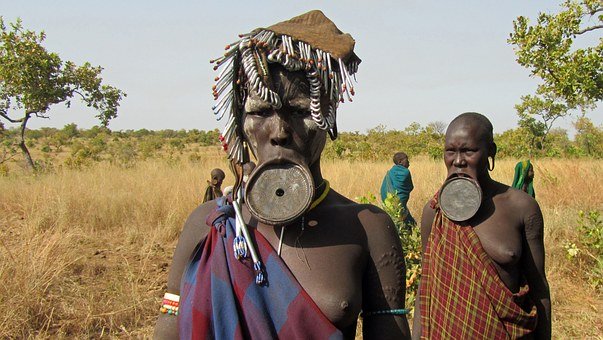
To experience the geological
diversity of the land you only have to fly into the 8,000-foot high capital.
The mountains and plateaus seem to rise up to meet you. Eucalyptus forests,
high canyons, steep gorges, scrub desert and ice-cold lakes are secret
untamed places for hikers, climbers and happy campers. You'll find yourself
eating Injera and Wat with your fingers. Injera is baked from a sourdough
batter and placed on your tabletop like a gigantic pancake. Wat is the
stew that's served in the middle of the Injera. You tear off a piece of
Injera and use it to scoop up the fiery stew (chicken, meat or vegetables).
You don't want to find yourself on the other end of a meal. At the Sudanese
border, the Baro River teems with crocodiles. Sadly, I lost a friend there.
See http://www.peacecorpswriters.org/pages/2001/0101/101cllook.html
Hyena Man
Addis Ababa is home to Ethiopian
Orthodox Churches, U.N. Economic Commission For Africa, museums and some
modern hotels that did not exist when I rubbed elbows with the little king!
Back then there were no streetlamps. After dark, hyenas skulked into the
city scavenging for anything they could get their jaws around, garbage
or human. There was a man, a prowler of shadows himself, who had a way
with the nasty predators.
Wandering the back alleys,
he mysteriously lured the beasts to him and then out of town, kind of like
a Pied Piper. We called him "the hyena man," and that is all we knew about
him. Present day "entrepreneurs" have made the former event into a thriving
business performed for tourists.
The Blue Nile Falls
We took off in a single engine
Cessna T-210 from the ancient capital of Gondar heading for Bahir Dar and
Lake Tana, source of the Blue Nile. In Ethiopia, everything was ancient,
including the Cessna. A former Korean War Ace, Walt had been spraying malaria-infected
areas for years. The Blue Nile, as opposed to the brownish White Nile in
Egypt, gets its name from the waters of Lake Tana, the largest lake in
Ethiopia, from whence the river flows to Khartoum and on into Egypt. Walt
didn't fly over the falls; he practically flew into them.
Swooping low on the first
run, I nearly lost my breakfast, but I asked him to do it again for a closer
shot. Staring up at me through the tree branches of the surrounding rainforest
was the white-fringed face of a silky black and white long-tailed monkey.
Hunted to near extinction for its beautiful coat, the Colobus Monkey, the
only kind of its species without a thumb, is an endangered acrobatic marvel
of grace and elegance.
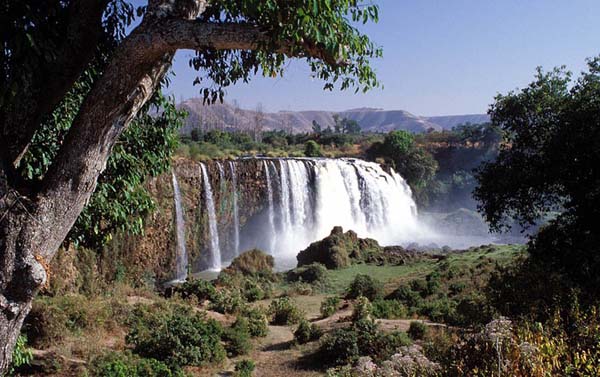
Photo by Jialiang Gao on
Wikimedia
Commons
Mist from the thundering
waters creates a rainbow bridge to the sun. I was snapping photos when
bullets began tearing through the fuselage, zapping Walt in his bottom.
We couldn't see the shooters but we knew they wanted the Cessna. Despite
terrible pain, the seasoned pilot wasn't going to let them have it. Shouting
obscenities over my prayers, he managed to hold on to the faltering plane
while the floorboards soaked up his blood. We arrived in Bahir Dar with
Walt's pride as wounded as his anatomy. After medical attention and a few
belts of Jack Daniels, the bush pilot was on cloud nine.
Rock Churches of Lalibela
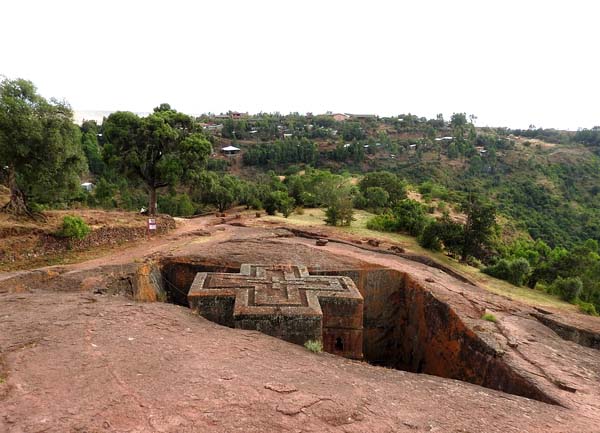
Ethiopian Airways' hotshot
pilots take off and land on postage stamp plateaus. A short flight from
Addis is the tiny town of Lalibela whose airport terminal, in my time,
was a tin roofed hut. Never mind. Hidden under ground are eleven monolithic
churches carved from rock. Built in the thirteenth century, the churches
are holy places of Ethiopian Christian pilgrimage. I had to crawl down
into the subterranean spaces on my hands and knees. Once inside, I was
in the Middle Ages. A priest with a torch stood in the darkness guarding
an altar and religious wall paintings. He looked like he'd been standing
there for 500 years! Monks tell you the Ark of the Covenant is similarly
hidden in a monastery in the ancient city of Axum, where Queen Sheba stayed
in the 10th century B.C. Someone should tell Steven Spielberg.
"Simplicity-Courage-Humor-Soul"®
Top
About the Author - A
writer/editor, I work with one client at a time, beginner or pro, for a
cost effective solution to your writing and editing needs. Contact me at
<www.susanscharfman.com> |
 |
Ethiopia:
Ancient Churches, Semitic Culture, and the Amharic Language by Jacob
Lumbroso
In the 1980s Ethiopia was largely
known in the international press for two reasons. The first was the tragic
famine that occurred in 1984-1985. The second, was the first exodus
of Ethiopian Jews to Israel in 1984 and subsequently followed by a second
exodus in 1991.
Ethiopia however, is probably
known for its historic place in early Christianity. The town of Lalibela,
for example, is among Ethiopia's holy cities and is renown for a
series of beautifully constructed rock-hewn churches. As a sacred site,
Lalibela is second only to the city of Askum. The most famous of
these churches is Bete Giryorgis.
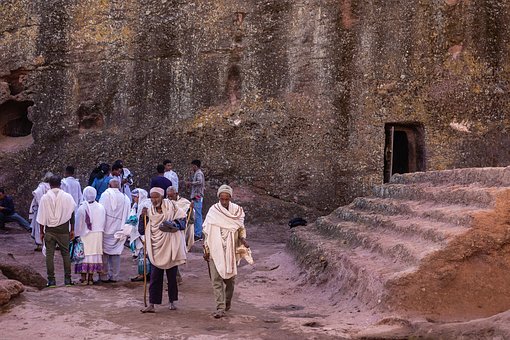
The overwhelming majority
of the population are members of the Ethiopian Orthodox Church and of Amhara
ethnicity. The layout of Lalibela is argued to reflect that of buildings
in Jerusalem. This is partly attributable to the residence of Gebre Mesqel
Lalibela in Jerusalem in his youth. Gebre eventually rose to rule
Ethiopia in the late 12th and 13th centuries CE.
The fall of Jerusalem to
Muslims in 1187, is the second reason that Lalibela reflects patterns of
Jerusalem. Biblical names are found throughout the region. The first European
to see these churches was the Portuguese explorer Pêro da Covilhã
followed by the explorer Franscisco Alvares in the 1520s. Roughly three
hundred years passed until Gerhard Rohlfs, another European explorer visited
Lalibela somewhere between 1865 and 1870.
Lalibela is home to 12 rock-hewn
churches. They include Bete Medhane Alem, home to the Lalibela Cross,
Bete Maryam, Bete Golgotha (known for its arts and said to contain the
tomb of King Lalibela), the Selassie Chapel, the Tomb of Adam, Bete Giyorgis,
arguably the best preserved church, Bete Amanuel, Bete Merkorios, Bete
Abba Libanos and Bete Gabriel-Rufael.
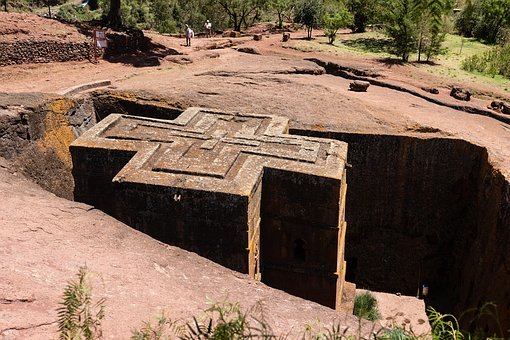
The Ethiopian connections
with Jerusalem and Semitic culture are further highlighted when remembering
that Semitic languages, of which Amharic is one, represent a family of
languages spoken by more than 300 million people across the Middle East,
North Africa, and the horn of Africa. After Arabic, Amharic is the second
most spoken Semitic language in the world.
The Amharic language is spoken
by the Amhara, an ethnic group in the central highlands of Ethiopia. The
Amhara comprise approximately 30 percent of the population, with about
27 million speakers. An additional 7-15 million people speak it as a second
language. It has been the working language of government institutions,
the military, and of the Ethiopic Orthodox church.
In addition to Ethiopia,
Amharic is also the language of some 2.7 million emigrants. The largest
population of émigrés live in Egypt, Israel, and Sweden.
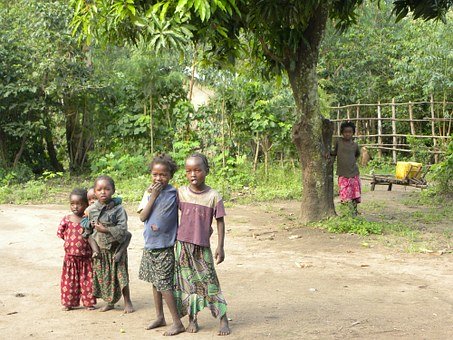
Increasing numbers of Ethiopians
and Eritreans have also emigrated to the United States. The Amharic language
is also spoken in Eritrea by some Eritreans as a vestige of past years
when Eritrea was part of the Ethiopia.
Top
About the Author:- Jacob
Lumbroso is a world traveler and an enthusiast for foreign languages, history,
and foreign cultures. He writes articles on history and languages for http://www.thelanguagechronicle.com
and has used Pimsleur courses to learn various languages. |
Angola
- Botswana - Burkina
Faso - Cameroon - Congo
- Eritrea - Ethiopia
- Gabon - Gambia -
Ghana
- Ivory Coast - Kenya
- Lesotho - Madagascar
- Malawi - Mauritius
- Mozambique -
Namibia
- Nigeria - Senegal
-
Seychelles - South
Africa - Swaziland - Tanzania
-
Tunisia
- Uganda - Zambia
- Zanzibar - Zimbabwe
Top
|

